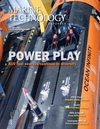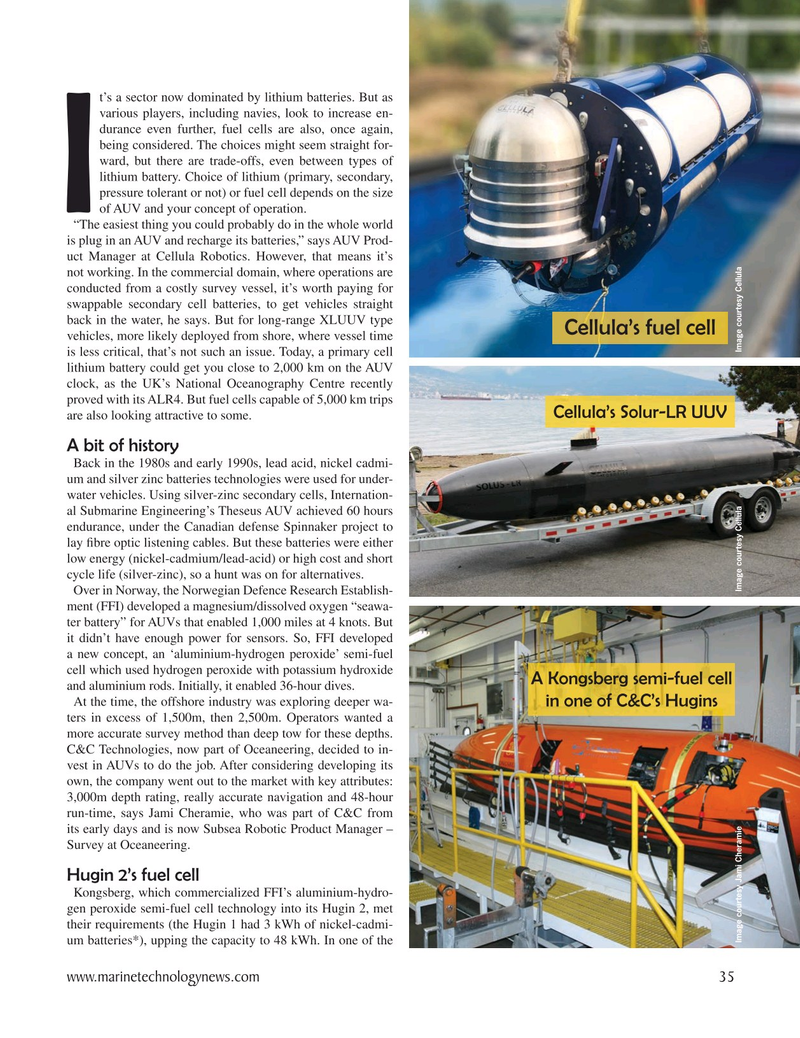
Page 35: of Marine Technology Magazine (July 2022)
Read this page in Pdf, Flash or Html5 edition of July 2022 Marine Technology Magazine
t’s a sector now dominated by lithium batteries. But as various players, including navies, look to increase en- durance even further, fuel cells are also, once again, being considered. The choices might seem straight for- ward, but there are trade-offs, even between types of lithium battery. Choice of lithium (primary, secondary, pressure tolerant or not) or fuel cell depends on the size
Iof AUV and your concept of operation. “The easiest thing you could probably do in the whole world is plug in an AUV and recharge its batteries,” says AUV Prod- uct Manager at Cellula Robotics. However, that means it’s not working. In the commercial domain, where operations are conducted from a costly survey vessel, it’s worth paying for swappable secondary cell batteries, to get vehicles straight back in the water, he says. But for long-range XLUUV type
Cellula’s fuel cell vehicles, more likely deployed from shore, where vessel time is less critical, that’s not such an issue. Today, a primary cell lithium battery could get you close to 2,000 km on the AUV clock, as the UK’s National Oceanography Centre recently proved with its ALR4. But fuel cells capable of 5,000 km trips
Cellula’s Solur-LR UUV are also looking attractive to some.
A bit of history
Back in the 1980s and early 1990s, lead acid, nickel cadmi- um and silver zinc batteries technologies were used for under- water vehicles. Using silver-zinc secondary cells, Internation- al Submarine Engineering’s Theseus AUV achieved 60 hours endurance, under the Canadian defense Spinnaker project to lay ? bre optic listening cables. But these batteries were either low energy (nickel-cadmium/lead-acid) or high cost and short cycle life (silver-zinc), so a hunt was on for alternatives.
Over in Norway, the Norwegian Defence Research Establish- ment (FFI) developed a magnesium/dissolved oxygen “seawa- ter battery” for AUVs that enabled 1,000 miles at 4 knots. But it didn’t have enough power for sensors. So, FFI developed a new concept, an ‘aluminium-hydrogen peroxide’ semi-fuel cell which used hydrogen peroxide with potassium hydroxide
A Kongsberg semi-fuel cell and aluminium rods. Initially, it enabled 36-hour dives.
At the time, the offshore industry was exploring deeper wa- in one of C&C’s Hugins ters in excess of 1,500m, then 2,500m. Operators wanted a more accurate survey method than deep tow for these depths.
C&C Technologies, now part of Oceaneering, decided to in- vest in AUVs to do the job. After considering developing its own, the company went out to the market with key attributes: 3,000m depth rating, really accurate navigation and 48-hour run-time, says Jami Cheramie, who was part of C&C from its early days and is now Subsea Robotic Product Manager –
Survey at Oceaneering.
Hugin 2’s fuel cell
Kongsberg, which commercialized FFI’s aluminium-hydro- gen peroxide semi-fuel cell technology into its Hugin 2, met their requirements (the Hugin 1 had 3 kWh of nickel-cadmi-
Image courtesy Jami Cheramie Image courtesy Cellula Image courtesy Cellula um batteries*), upping the capacity to 48 kWh. In one of the www.marinetechnologynews.com 35
MTR #5 (34-49).indd 35 6/30/2022 1:20:48 PM

 34
34

 36
36
